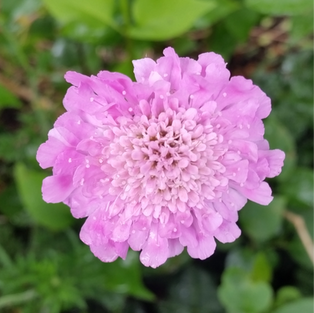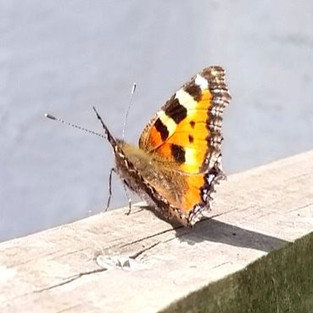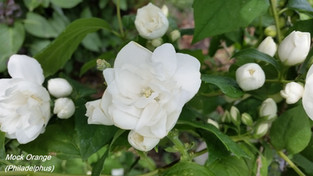Hooray for Bees!
- Clare
- Jun 12, 2020
- 5 min read

I have a favourite place to sit in my garden. It is on the steps that lead down to the narrow river that runs through the garden. I have to admit that it is not (yet) the prettiest of spots as the opposite bank is not easily accessible and therefore is still predominantly a wilderness. However, this is one of the few places that is obscured from the overlooking windows of neighbouring houses and I find that I enjoy the occasional solitude. I can smell the adjacent lilac blossom when it is in bloom, and subsequently the honeysuckle and lavender that sits close by. The ducks sometimes rest in the shade next to me, and here we sit, watching the river flow by.
I took my early cup of tea outside today and sat briefly on the steps to watch the morning action. A lovely thrush was singing loudly from a willow tree (I would not have recognised its call had I not seen it!) and a blackbird was hopping around the lawn looking for food. A tortoiseshell butterfly was collecting nectar and the bees were buzzing around the lovely little Campanula bells and the pink pincushion flower heads of the Scabious. I could have watched them for longer, but home schooling was calling and the ducks were also waddling hurriedly towards the house looking for a possible breakfast.
As I walked back inside I stopped for a moment to watch a bumble bee flying between the remaining foxgloves and was reminded of a factoid I once read which reported that 100,000 plant species would cease to exist if there were no bees to pollinate them. 100,000?! Its a remarkable figure when you think about it and, whilst I cannot vouch for the veracity of this particular claim, the important role that bees play in the cross-pollination of plants (including many of our own food crops) is well understood. So much of what we eat is at least partly reliant on the activity of bees and it is a sad truth that their numbers have decreased drastically over the past fifty years due to changing farming practices, loss of habitat and the impact of diseases, such as those transmitted by the well publicised varroa mite. Fortunately, this decline is something we can all help to address by simply planting more flowers in our gardens and using insecticides as infrequently as possible.
There are many articles which list the "best" plants for bees, though personally I think a variety of flowers is most favourable, paying particular attention to native plants where possible and trying to achieve year long flowering. Some of the best plants I have observed for bees include the well known blues and purples such as lavender and Californian lilac, but also not forgetting the likes of cornflowers, green alkanet, nettle flowers and rosemary. In our own garden, the honey bees also love the small thyme flowers, whilst several bumble bee species seem to favour the foxgloves and the cotoneaster. Earlier in the year, apple blossom is a firm favourite, whilst in Autumn and Winter, the sedum, ivy flowers and heather are covered in bees looking for a late source of nectar. Even the little daisies and clover flowers are valuable sources of food and remind me that a few weeds in the lawn is not necessarily a bad thing!
Bees can also be encouraged into the garden by creating a "bee hotel" in a sunny spot, which solitary bees can use to lay their eggs. The Gardeners' World website provides instructions that show how a simple bee hotel can be created and also describes how a terracotta pot could be used to make a nesting site for bumblebees:
https://www.gardenersworld.com/how-to/diy/how-to-make-a-bumblebee-nest/
My parents also sent me the following picture recently which shows a nest made by a colony of bumblebees (possibly a tree bumblebee Bombus hypnorum) in an unused bird box on the side of their garage. A pair of sparrows had started to build a nest there earlier in the year, but had abandoned it in preference of another site and the bees had promptly moved in. Left undisturbed, they are not aggressive and will disperse or die out later in the year (usually by late July). Only the young queens will hibernate over Winter before starting the cycle again next year.

My parents also sent me the following image which shows the freshly weeded rockery in their Cheshire garden. I included it as the colours are so bright and cheery (though it did make me feel a little homesick!) and it is always nice to see pictures of the plants in other people's gardens!

In our own garden, the daylilies, penstemon and mock orange are flowering, and poppies and daisies are opening up everywhere.
The roses seem to be taking a break and I spent some time this week going round the garden, making sure I had dead headed all the rose bushes. I also thinned out the creeping St Johns Wort (Hypericum) which looks pretty when in flower, but spreads vigorously by underground runners:

I also started work on the apple tree, thinning out the clusters of young apples to one or two fruit:

Finally this week, I finished potting up the Kalanchoe and Sempervivum cuttings that I had taken at the end of last week. After finding out relatively recently that the secret to propagating succulents is leaving unrooted cuttings to dry out before re-planting, I am working my way around all the varieties I have in the house and garden (there aren't many and therefore it shouldn't take me too long!).
It is a few weeks since I suggested any nature related activities for children and therefore I have included a few more simple ideas below:

Make a model bee using an old toilet roll, some paper and paints!
2. Make a mini garden on a plate. I recall that every summer fayre I attended at my old primary school would include a competition for the best "garden in a plate". The idea was to create a garden in miniature on a dinner plate, using material such as soil, moss, sand, toys and flowers. There are some lovely examples on the internet if you need inspiration and, if the prospect of using soil or sand doesn't appeal, you could create a garden diorama using just paint and cardboard (NB this idea could also be varied for older primary school children who are studying different habitats).
3. Regrow food! Several plants can be encouraged to regrow by simply placing them in water. We do this regularly with our lettuces, i.e after the leaves have been removed, we place the stalk in water and the lettuce will "regrow" after just a few days. There are lots of other examples you could try such as avocado stones, celery, pineapple and spring onions. Some shop-bought cut herbs may also re-root if placed in water (we have had successes with rosemary, thyme and lemon grass).

4. Grow a herb garden. The great thing about herbs is that they can be grown in a pot on the windowsill as well as in the garden. They are great plants for a sensory garden and the children can experiment by using them in different recipes.
5. Decorate a flower pot. Why not pot up your herbs in some freshly decorated pots?
Terracotta pots are great for painting, or you could stick on stones, shells, twigs, string, or even the dreaded glitter!

























Comments